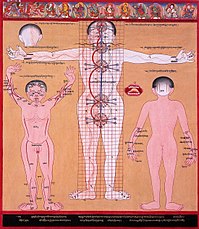| Trul khor | |||||
| Tibetan name | |||||
|---|---|---|---|---|---|
| Tibetan | རྩ་རླུང་འཁྲུལ་འཁོར་ | ||||
| Literal meaning | magical movement instrument, channels and inner breath currents | ||||
| |||||

Trul khor ('magical instrument' or 'magic circle;' Skt. adhisāra[1]), in full tsa lung trul khor (Sanskrit: vayv-adhisāra 'magical movement instrument, channels and inner breath currents'), also known as yantra yoga, is a Vajrayana discipline which includes pranayama (breath control) and body postures (asanas). From the perspective of the Indo-Tibetan Buddhist traditions of Dzogchen, the mind is merely vāyu (breath or, more literally, wind) in the body. Thus working with vāyu and the body is paramount, while meditation, on the other hand, is considered contrived and conceptual.
Namkhai Norbu Rinpoche (1938-2018), a proponent of trul khor, preferred to use the equivalent Sanskrit-derived English term 'yantra yoga' when writing in English. Trul khor derives from the instructions of the Indian mahasiddhas (great sages) who founded Vajrayana (3rd to 13th centuries CE).
Trul khor traditionally consists of 108 movements, including bodily movements (or dynamic asanas), incantations (or mantras), pranayama and visualizations.[citation needed]
The walls of the Dalai Lama's summer temple of Lukhang depict trul khor asanas.
- ^
Wallace, Karma Chagmé ; with commentary by Gyatrul Rinpoche ; translated by B. Alan (1998). A spacious path to freedom : practical instructions on the union of Mahāmudrā and Atiyoga. Ithaca, N.Y.: Snow Lion Publications. p. 69. ISBN 1559390719.
{{cite book}}: CS1 maint: multiple names: authors list (link)